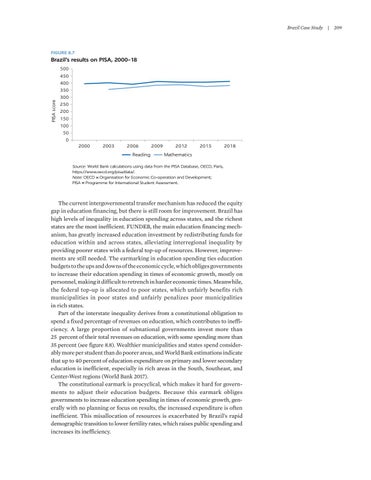Brazil Case Study | 209
FIGURE 8.7
PISA score
Brazil’s results on PISA, 2000–18 500 450 400 350 300 250 200 150 100 50 0 2000
2003
2006 Reading
2009
2012
2015
2018
Mathematics
Source: World Bank calculations using data from the PISA Database, OECD, Paris, https://www.oecd.org/pisa/data/. Note: OECD = Organisation for Economic Co-operation and Development; PISA = Programme for International Student Assessment.
The current intergovernmental transfer mechanism has reduced the equity gap in education financing, but there is still room for improvement. Brazil has high levels of inequality in education spending across states, and the richest states are the most inefficient. FUNDEB, the main education financing mechanism, has greatly increased education investment by redistributing funds for education within and across states, alleviating interregional inequality by providing poorer states with a federal top-up of resources. However, improvements are still needed. The earmarking in education spending ties education budgets to the ups and downs of the economic cycle, which obliges governments to increase their education spending in times of economic growth, mostly on personnel, making it difficult to retrench in harder economic times. Meanwhile, the federal top-up is allocated to poor states, which unfairly benefits rich municipalities in poor states and unfairly penalizes poor municipalities in rich states. Part of the interstate inequality derives from a constitutional obligation to spend a fixed percentage of revenues on education, which contributes to inefficiency. A large proportion of subnational governments invest more than 25 percent of their total revenues on education, with some spending more than 35 percent (see figure 8.8). Wealthier municipalities and states spend considerably more per student than do poorer areas, and World Bank estimations indicate that up to 40 percent of education expenditure on primary and lower secondary education is inefficient, especially in rich areas in the South, Southeast, and Center-West regions (World Bank 2017). The constitutional earmark is procyclical, which makes it hard for governments to adjust their education budgets. Because this earmark obliges governments to increase education spending in times of economic growth, generally with no planning or focus on results, the increased expenditure is often inefficient. This misallocation of resources is exacerbated by Brazil’s rapid demographic transition to lower fertility rates, which raises public spending and increases its inefficiency.






